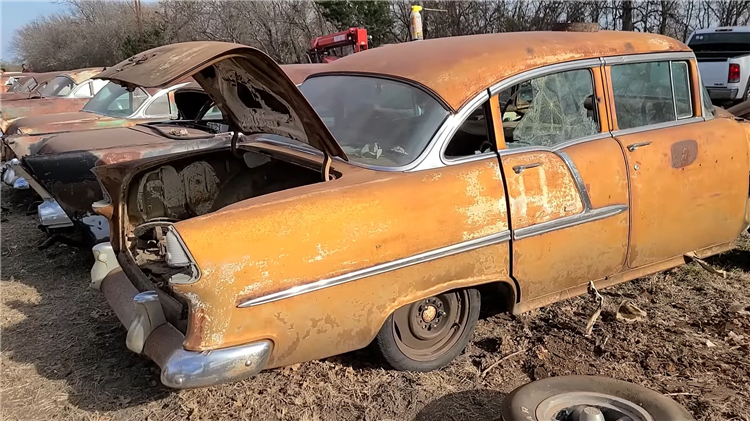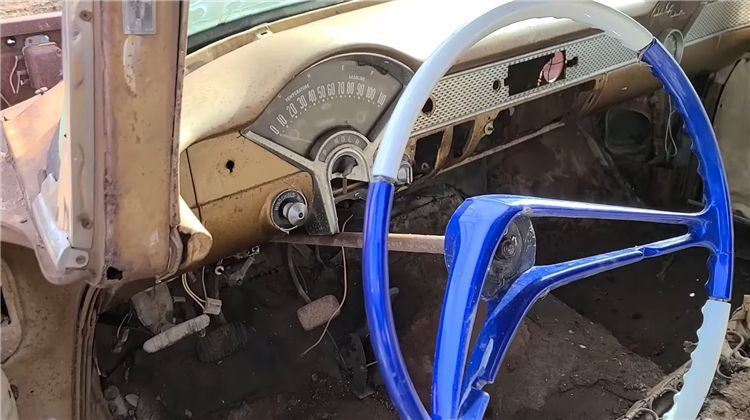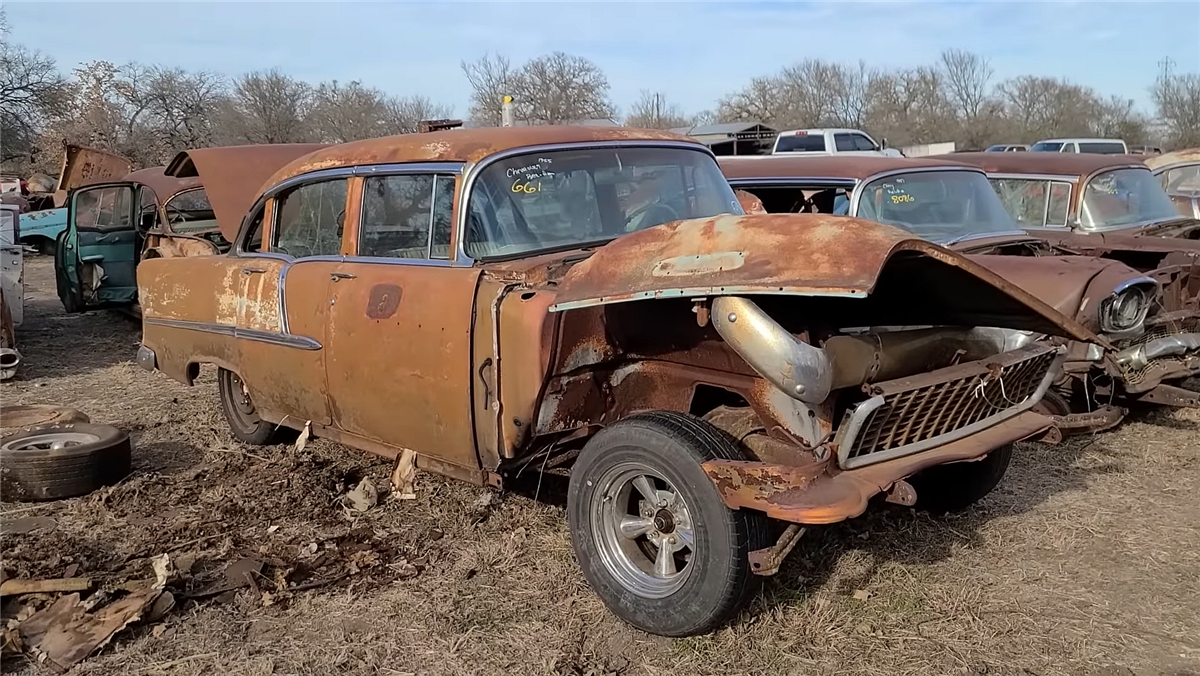William C. Durant founded General Motors in 1908, and it didn’t take the company long to acquire a large number of automakers. Among other brands, GM had already acquired Cadillac, Buick, Oldsmobile, Chevrolet, and Pontiac by 1920. The business was dubbed the biggest automobile conglomerate in the world in 1931.
In its first few decades on the market, General Motors produced tens of millions of cars under the umbrella of its five main brands. During the post-World War II economic boom, the corporation achieved the 50 million milestone. More specifically, a 1955 Chevrolet two-door hardtop was the 50 millionth vehicle to roll off the manufacturing line for General Motors in November 1954.
Of course, GM celebrated this important event accordingly. The Chevrolet in question, which was part of the then-new Tri-Five series, was given special treatment as it moved through the factory. A range-topping Bel Air Sport Coupe model, it emerged with a gold-plated body and matching chrome trim and wheel covers.
Driven off the Flint, Michigan assembly line by Chevrolet General Manager Thomas Keating, the car was almost immediately loaded onto a flatbed float and paraded through the city alongside other important automobiles, including the first Cadillac built under GM ownership. After that, the gold Bel Air spent some time on the auto show tour.

But is this special Tri-Five still around? Well, the story goes that at some point the Sport Coupe ended up in private ownership and then disappeared off the radar. It resurfaced decades later when a restorer got it in a trade and discovered gold-plated trim elements in the trunk.
When word got out that the VIN matched that of the 50 millionth car, General Motors supposedly offered to restore it should the owner allow the company to use it as a promotional vehicle. He reportedly turned down the offer, and the Bel Air disappeared again when the owner passed away.
Even though the gold-plated Tri-Five was unique, other cars were also created to commemorate the momentous occasion. Additionally, Chevrolet created a gold-colored Commemorative Edition (also known as the Golden Anniversary) that was not offered on production cars at the time. The finish was only available on Bel Air four-door sedans, and only 5,000 of them were produced. These were offered for sale at a few dealerships around the country.
These jubilee Bel Airs were identical to the standard production four-door cars except for the special color. Thus, even though they were rather exotic at the time, many of them suffered abuse, just as the majority of the five million Tri-Fives constructed between 1955 and 1957.
Abandoned in junkyards or locked up in barns, most of them became rust buckets. And the fact that four-door Bel Airs are nowhere near as popular as the Sport Coupe models on the classic car market didn’t help either. Come 2023, and only a few of these Commemorative gold-painted cars are still around. And those that survived have been repainted at some point, so unrestored and unmolested examples are rarer than hen’s teeth.
Last time I saw one of these cars pop up for sale it was December 2021, and the online ad for it had a buy-it-now sticker of almost $25,000. The Bel Air had been repainted gold and had its original V8 engine swapped with a small-block 350-cubic-inch (5.7-liter) mill. I have no idea if it found a new owner or not, but it took more than a year to see another anniversary model online.
But this one’s not for sale and it’s also in pretty bad shape. Yup, it’s one of those cars that was left to rot away in a backyard before being moved to a junkyard. Fortunately enough, an enthusiast that knows what this golden Commemorative Edition is all about found it and bought it before it was sent to the crusher.

Not surprisingly, given the amount of time it spent fully exposed to the elements, the original gold paint is barely visible. On top of that, it appears that someone repainted the top and upper rear fenders white in an attempt to turn it into a two-tone Chevy. So how do we know this Tri-Five is one of those limited-edition Bel Airs?
Well, these cars left the assembly line with a special paint code, which was 689. Fortunately, this Bel Air still has its trim tag and the lower section clearly shows “paint no. 689.” So unless someone pulled a very time-consuming prank on the owner, this Bel Air is one of those 5,000 four-door sedans that left the factory with a special gold color.
The footage below shows that the car is in pretty rough condition. It’s missing the front fenders, a couple of windows are cracked, and the paint has faded away to the point where it’s barely recognizable. On the flip side, most of the chrome trim is still on the car and the body doesn’t show severe rust issues.
For a car that has been off the road for what must be more than thirty years, the interior also appears respectable. The lovely gold console and the two-tone door panels are still there, even though the floors have a few holes in them, the seats are toasty, and the steering wheel has been replaced. The engine and transmission are missing, despite the tag indicating that the car had a six-cylinder engine at first. In summary, a comprehensive restoration is required for this Chevrolet to reclaim its previous splendor.
But here’s the good news: the person who bought it (for only $250!) wants to put it back on the road. And this mission isn’t quite as complicated as it sounds. Being a four-door Bel Air, it’s the kind of car that can be put back together with cheaper parts. Four-door components aren’t as expensive as Sport Coupe parts, and Chevy inline-six engines from the era are far from costly. In fact, they’re quite easy to find for cheap at any junkyard that has a stash of Tri-Fives.
As a refresher, the 1955 Bel Air four-door sedan came with a 235-cubic-inch (3.9-liter) six-cylinder powerplant as standard. Related to the Blue Flame offered in the Corvette at the time, the mill was good for 123 horsepower and 207 pound-feet (281 Nm) of torque at the time. The lineup also included a 265-cubic-inch (4.3-liter) V8 rated at 150 to 180 horsepower.
While I’d rather stuff a period-correct V8 under the hood of this machine, there’s nothing wrong with the owner wanting to restore it to factory specifications. It might actually be more valuable with a 1955 inline-six than as a restomod. But the important thing is that this special Bel Air returns to public roads with a fresh layer of gold paint as soon as possible.
